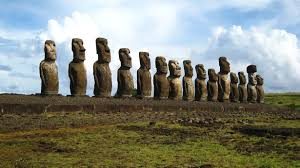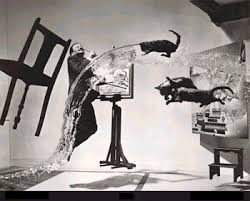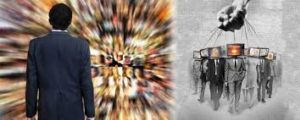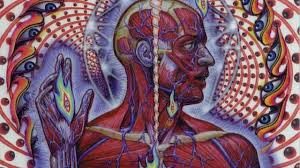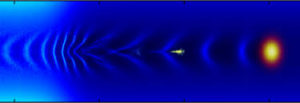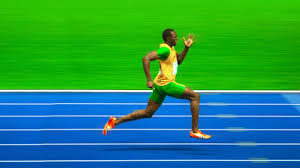The genetic system not only contains and conveys information, but it also reacts to information from the physical and cultural worlds.

In a way I hope to explain, then, the genetic system also reacts to those beliefs and events that are paramount in any given civilization. Events can trigger genetic activity — not simply through, say, chemical reactions, but through individual and mass beliefs about the safety or lack of it in the world at large.
There are also what I will call genetic dreams, which are inspired directly by genetic triggering. These help form and direct consciousness as it exists in any given individual from before birth.

The fetus dreams. As its physical growth takes place in the womb, so the sleeping of its consciousness is also extended by genetic dreams. These particular fetus-oriented dreams are are most difficult to describe, for they are actually involved with forming the contours of the individual consciousness. Such dreams provide the subjective understanding from which thoughts are developed, and in those terms complete thoughts are possible before the brain itself is fully formed. It is the process of thinking that helps bring the brain into activity, and not the other way around.
Such thoughts are like, now, electrical patterns that form their own magnets. The ability to conceptualize is precise in the fetus, and the fetus does conceptualize. The precise orientation of that conceptualizing, and the precise orientation of the thinking patterns, wait for certain physical triggers received from the parents and the environment after birth, but the processes of conceptualization and of thought are already established. This establishment takes place in genetic dreams.

Infants think long before they can speak. Thought must come before language. Language is thought’s handmaiden.
The ability to use language is also genetically built-in, through the precise orientation, again, with the physical triggering of the parents’ native language. Children learn such languages mentally long before they are physically capable of speaking them; but again, in genetically inspired dreams, children — or rather, infants — practice language. before such infants hear their parents speak, however, they are telepathic communication, and even in the fetus genetic dreams involve the coding and interpretation of language. Those dreams themselves inspire the physical formation necessary to bring about their own actualization.

Genetic dreams of one kind or another continue throughout our lives, whether or not we are consciously aware of them. They were of prime importance in “man’s and woman’s evolution,” as we think of it. They were the source of dreams, mentioned in earlier blogs, that sent man and woman on migrations after food, that led him or her toward fertile land. Those dreams are most closely related to survival in physical existence, and whenever that survival seems threatened such dreams arise to consciousness whenever possible.
They are the dreams that warn of famines or of wars. Such dreams, however, can also be triggered often, as in our own times, when the conscious mind is convinced that the survival of the species is threatened — and in such cases the dreams then actually represent man’s and woman’s fears. Over-anxiety, then, can confuse the genetic system, and in a variety of ways. The existence of each of the species is dependent upon trust, indeed a biological optimism, in which each species feels the freedom to develop the potential of its members in relative safety, within the natural frameworks of existence. Each species comes into being not merely feeling a natural built-in trust in its own validity, but is literally propelled by exuberance in its ability to cope with its environment. It knows that it is uniquely suited to its place within life’s framework. The young of all species exhibit an unquenchable rambunctiousness. That rambunctiousness is built in.

Animals know that their lives spell our life’s meaning. They feel their relationship with all other forms of life. They know that their relationship with all other forms of life. They know that their existences are vitally important in the framework of planetary existence. Beyond that, they identify themselves with the spirit of life within them so fully and so completely that to question its meaning would be inconceivable. Not inconceivable because such creatures cannot think, but because life’s meaning is so self-evident to them.
Whenever man or woman believes that life is meaningless, whenever he or she feels that value fulfillment is impossible, or indeed nonexistent, then he or she undermines his or her genetic heritage. He or she separates himself and herself from life’s meaning. He or she feels vacant inside. Man and woman for centuries attached faith, hope, and charity to the beliefs of established religions. Instead, these are genetic attributes, inspired and promoted by the inseparable unity of spirit in flesh. The animals are quite as familiar with faith, hope, and charity as we are, and often exemplify it in their own frameworks of existence to a better extent. Any philosophy that promotes the idea that life is meaningless is biologically dangerous. It promotes feelings of despair that directly hamper genetic activity. Such philosophies are extremely disadvantageous creatively, since they dampen the emotional spirits and exuberance, and sense of play, from which creativity itself emerges.

Such philosophies are also deadening on an intellectual basis, for they must of necessity close out man’s and woman’s great curiosity about the subjective matters that are his and her main concern. If life has no meaning, then nothing else really makes any difference, and intellectual curiosity itself also ends up withering on the vine.
The intellectual ideas of societies, therefore, also have a great effect upon which genetic systems are triggered, and which ones are not.

We have genetic systems, then, carrying information that is literally incalculable. Now: through our technologies, through our physical experience, we are also surrounded by an immense array of communication and information of an exterior nature. We have our cell-phones, radios, computers, televisions, our earth satellites — all networks that process and convey data. Those inner biological systems and the exterior ones may seem quite separate. They are intimately connected, however. The information we receive from our culture, from our arts, sciences, fields of economics, is all translated, decoded, turned into cellular information. Certain genetic diseases, for example, may be activated or not activated according to the cultural climate at any given time, as the relative safety or lack of it in that climate is interpreted through private experience.
In one way or another, the living genetic system has an effect upon our cultural reality, and the reverse also applies. All of this is further complicated by the purposes and intents of the generations in any historical period, and the reincarnational influences.

Value fulfillment always implies the search for excellence — not perfection, but excellence. Excellence in any given area — emotional, physical, intellectual, intuitional, scientific — is reflected in other areas, and by its mere existence serves as a model for achievement. This kind of excellence need not be structured, then, into any aspect of life, though it may appear in any aspect, and wherever it appears it is an echo of a spiritual and biological directive, so to speak. There are different historical periods, in our terms, where the species has showed what it can do — and what is possible in certain specific directions when the genetic and reincarnational triggers are touched and opened full blast, so that certain characteristics appear in their clearest, most spectacular light, to serve as individual models and as models for the species as a whole.
Again, such times are closely bound with reincarnational intents that direct the genetic triggering, and that meet in the culture the further stimulus that may be required. The time of the great masters in the fields of painting and sculpture is a case in point.

Some people have built careers around negative beliefs– they may have spent their professional lives maintaining belief systems which after death they begin to understand are quite wrong. How do they react? Are those individuals even aware of their earlier beliefs? Do they care what they used to think? Are they shocked, do they have feelings of regret or embarrass what? Or is there such a variety of responses possible that we can’t answer the question simply? And how do such people react after death, they start to get glimmerings about the workings of reincarnation, for example?
Reincarnational patterns apply also. Some people, having live lives believing in one religious system or another, being completely immersed in them give themselves shock treatments of sorts, then, living lives in which they believe in nothing or at least freeing themselves from any beliefs — only to discover, of course, that a believing nothing is the most confining belief of all. That realization is that in such cases.

There are those who upon religious beliefs, using them as crutches, and in later lives then, they might– such people — throw those crutches away overreacting to their new-found “freedom”; and through living lives as meaningless they then realize, after death, the meaningfulness of existence was after all not dependent upon any religious system. It was there all along, but they had not seen it.

“If there is no life after life,
then what cosmic spendthrift formed
the universe,
for Chance alone can’t be
that prolific, or fake an order in which
an accident of such proportions
as the creation of a world
seems so inevitable,
each random element
falling pat, into place.,
and each consciousness promptly appearing
with body parts all neatly assembled —
only to be squandered,
falling apart, dissolving into nothingness
while Chance grinds out newer odds.
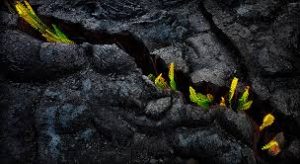
If there is no life after life,
then what a lack
of cosmic economy,
for nature strings one molecule
on to another so craftily
that each seed can grow a tree,
and contains the properties
of an entire forest,
while multiplications
are hidden everywhere.”




